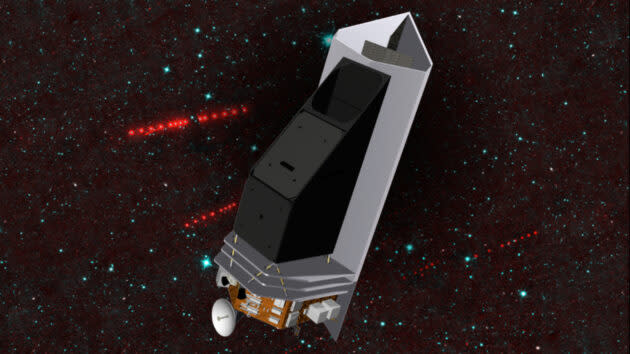NASA science chief says NEO Surveillance Mission will seek out threatening asteroids

The head of NASA’s science operations says the space agency intends to develop a new space-based infrared telescope to hunt down near-Earth objects — not primarily for science’s sake, but to ensure that potentially threatening space rocks are identified before they hit us.
NASA’s NEO Surveillance Mission will make use of technologies developed for a proposed telescope known as NEOCam, Thomas Zurbuchen, the agency’s associate administrator for science, said today during a meeting of NASA’s Planetary Science Advisory Committee in Washington, D.C.
NEOCam has long been considered as a candidate science mission under NASA’s Discovery Program. But today, Zurbuchen said the NEO Surveillance Mission would be recast as a planetary defense mission with NASA’s Jet Propulsion Laboratory playing the lead development role.
In a slide presentation prepared for the meeting, Zurbuchen emphasized that the mission’s main goal would be to identify potential threats to Earth rather than gaining scientific insights into the nature of near-Earth objects. “NASA does NOT approach planetary defense as a science-driven mission line; instead, we approach these missions more like space weather, NOAA or other operational programs,” Zurbuchen wrote.
The space telescope, scheduled for launch by as early as 2025, would focus on near-Earth asteroids wider than 140 meters (460 feet). The goal would be to identify 65% of such potentially hazardous asteroids, based on statistics, five years after the mission’s launch. Within 10 years, the mission should raise that figure to 90%.
If that level of detection could be achieved, it would finally satisfy a planetary defense mandate that was instituted by Congress back in 2005. That mandate followed up on a requirement to detect 90% potentially hazardous near-Earth objects bigger than 1 kilometer (0.6 mile) — a requirement that was met in 2010.
A 140-meter-wide asteroid isn’t thought to be wide enough to cause a global catastrophe on the scale of the dinosaurs’ extinction if it were to hit Earth. But experts say it could wipe out a city in the event of a direct hit.
Reports based on NASA internal documents revealed that an asteroid potentially close to that size range, known as 2019 OK, came within 41,000 miles of Earth in late July with just a day’s advance notice. Lindley Johnson, NASA’s planetary defense officer, estimated 2019 OK’s width at 57 to 130 meters (187 to 427 feet).
The key piece of hardware for the NEO Surveillance Mission would be a 50-centimeter (20-inch) wide-field infrared telescope, capable of launch on a SpaceX Falcon 9 or a United Launch Alliance Atlas 5 rocket. The spacecraft would conduct observations from a gravitational balance point between Earth and the sun, known as L1. Data would be delivered each day to the Minor Planet Center for analysis over the course of the anticipated 12-year mission.
Total mission cost would be in the range of $500 million to $600 million.
NASA has been funding planetary defense activities for several years at the level of $150 million a year. The space missions currently covered by the program include the Near-Earth Object Wide-field Infrared Survey Explorer, or NEOWISE; and the Double Asteroid Redirection Test, or DART, which is due for launch in 2021 and aims to determine how much a kinetic impactor could deflect an asteroid.
The space agency also funds ground-based telescope surveys of near-Earth objects. The new mission will probably require an increase in the planetary defense budget.
Hat tip to Marcia Smith at Space Policy Online.
More from GeekWire:
‘Smallsats are big’: NASA official details initiatives to boost tiny science satellites
White House lays out updated plan for detecting (and deflecting) killer asteroids
After review, NASA resets Webb Telescope launch for 2021 with $9.66B price tag
Hubble Space Telescope goes into safe mode due to failed gyro; Plan B pending